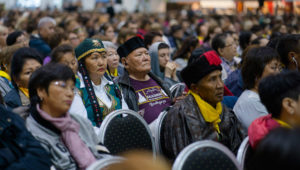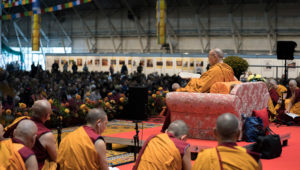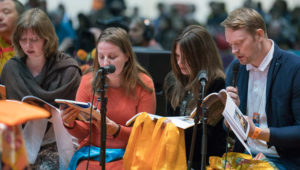Meeting with the Media and Teaching ‘Stages of Meditation’ & ‘Concise Stages of the Path’
[dalailama.com] Riga, Latvia, Sep 23 – The weather was clear and Riga’s tree filled parks were dappled with sunlight this morning as His Holiness the Dalai Lama drove to the teaching venue—the Skonto Hall. His first engagement was to meet with members of the media.
“I’m happy to be here,” he told them. “As human beings we are all the same, and if we pay too much attention to secondary differences between us it can result in conflict and violence. Our faces are the same. We all have two eyes, one nose and one mouth. Behind these faces our minds and emotions are the same. The important thing is that we all want happiness and peace—violence disturbs this.
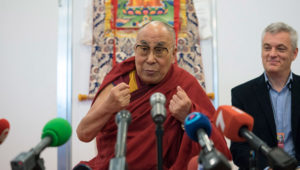
“Climate change is not limited to this or that country, it affects us all. Nature is teaching us that human beings should work together as one community. I am committed to promoting awareness that we are all one in being human. In addition, since all major religious traditions carry a common message of love and compassion, I’m committed to fostering harmony and respect between them. You media people could contribute to this too.”
The first question His Holiness was asked related to areas of conflict in the world today. He responded, “It’s still early in the 21st century, but reality has changed. However, old ways of thinking still prevail, especially in the minds of some leaders. They still cling to 20th century notions that problems can be solved by force. This counterproductive, out of date approach must change.
Asked about his recollections of Geshe Wangyal, His Holiness recalled that when he was still young in Tibet there were about 100 scholars from Kalmykia, Buryatia and Tuva in Lhasa, Geshe Wangyal among them. He mentioned that he has been unable to take up the invitation of the former Kalmyk President to come to Kalmykia to inaugurate a temple there housing statues of the 17 Masters of Nalanda.
He explained that he has lately been coming to Latvia because interested Russians have urged him to teach, but while he is presently unable to travel to Russia, many of them cannot afford to come to India—Latvia is where they can meet. He added that when you’re faced with difficulty is the best time for spiritual practices like patience and tolerance.
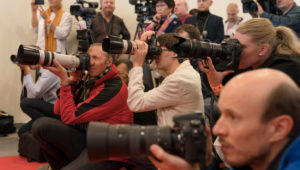
“Today, I’ll be giving a teaching mainly for people from Russia,” His Holiness began, “which recognises Buddhism as one of its religious traditions. Kalmyks, Buryats and Tuvans are not only traditionally Buddhist; they have a historic connection to Tibetan Buddhism.
“In the West, where the traditional faith is not Buddhist, I’m cautious about teaching Buddhism directly. In Germany and Italy, where I’ve just been, I talked more about philosophy and psychology. I had a good Christian friend, Brother Wayne, with whom I would discuss techniques for developing concentration and cultivating compassion. But when it came to emptiness, I told him not to ask. I was concerned that explaining how things are interdependent and described as like an illusion could undermine his faith in God.
“What does religion mean in the 21st century? Is it relevant in the face of so much technological and scientific development? These days people may find relief from stress in medication, but that won’t help them reduce their negative emotions. The way to do that is to transform the mind. Education and religion have taken different directions. Care for our inner world has been left to religion, but its influence is in decline.
“Therefore there’s a place for secular ethics—secular in the Indian sense of unbiased respect for all religions. We are looking into how to incorporate secular ethics in education. Emory University, for example, is preparing to publish a curriculum for schools and the Tata Institute for Social Sciences has just launched a program for higher education.
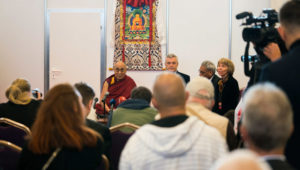
“After his enlightenment, having spent six years observing austerities and engaging in the various meditative absorptions, the Buddha is said to have thought—
Profound and peaceful, free from complexity, uncompounded luminosity—
I have found a nectar-like Dharma.
Yet if I were to teach it, no-one would understand,
So I shall remain silent here in the forest.
“Nevertheless, in due course he met his five former companions in Sarnath and at their request he taught the Four Noble Truths. He explained how mindfulness of the body yields understanding of suffering, mindfulness of feelings discloses understanding of its origins, mindfulness of the mind reveals understanding of cessation and mindfulness of the Dharma lays bare the path. The explanation of the Four Noble Truths and their sixteen aspects is common to all Buddhist traditions.”
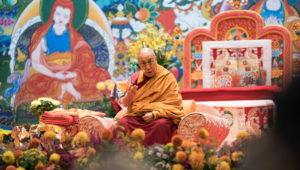
His Holiness explained that the Buddha mentioned the selflessness of persons in the first turning of the wheel of Dharma. However, only in the second turning of the wheel did he reveal that the five aggregates are ‘also empty of any inherent nature of their own’. This is why the ‘Heart Sutra’ states, ‘Form is empty, but emptiness is form. Emptiness is not other than forms and forms are not other than emptiness.’ Thus he made known the Two Truths, conventional and ultimate. In the third turning of the wheel, he divulged Buddha nature.
His Holiness mentioned a 19th century Tibetan Lama’s appraisal of the Buddha’s teachings as comprising a general structure and specialized teachings. The sutras consist by and large of the general structure, while the tantras are included in specialized teachings given to specific disciples. What His Holiness wanted to make clear is that it is difficult to practise tantra effectively without a background in the general structure of the teachings. Kamalashila’s ‘Stages of Meditation’ and Tsongkhapa’s ‘Concise Stages of the Path’, both belong to the general structure.
After Shantarakshita had come to Tibet and established the study and practice of Buddhism there, he predicted that a dispute would arise that his disciple Kamalashila would be best able to resolve. Consequently, Kamalashila composed ‘Stages of Meditation’ at Emperor Trisong Detsen’s request. The ‘Concise Stages of the Path’ follows the pattern set by Atisha’s ‘Lamp for the Path’, which he wrote for Tibetans at the request of Jangchub-ö in the 11th century. This pattern was the model for many other texts such as Longchenpa’s ‘Trilogy on Finding Comfort and Ease’ and Gampopa’s ‘Jewel Ornament of Liberation’.
His Holiness alternated his reading of the two texts, completing the section on identifying the nature of suffering in ‘Stages of Meditation’ and the instructions for a person of initial scope in the ‘Concise Stages of the Path’. At the end of the morning, he announced that he would conduct a ceremony for generating the awakening mind of bodhichitta when he resumes teaching tomorrow.
